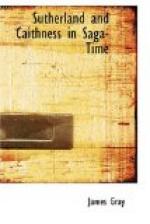Of Magnus son of Gilchrist, Earl of Angus, we know something. He was alive in 1227, when he attested the record of the perambulation of the boundaries of the lands of the Abbey of Aberbrothock,[5] and in the List of the Oliphant family charters dated 1594 in the Register House in Edinburgh there is an entry of “Ane charter under the Great Seill made be Alexr to Magnus sone to Gylcryst sometime Earle of Angus of the Erledome of South Caithness” which included Berridale and lands which Magnus’ granddaughter’s great-grandson Malise II conveyed to Reginald Chen III, known as “Morar na Shein,” after 1340.
It has been suggested that after Earl John’s death in 1231, the successor to the earldom of Caithness was a minor, which Earl Gilchrist’s son, Magnus, could not have been in 1231, and that this minor and ward was a son of Magnus, and bore the same name as his father.
The wardship seems at first sight to be proved in Robertson’s Early Kings,[6] and the proof is to the following effect:—Malcolm of Angus attested a charter in Earl John’s lifetime on 22nd April 1231, using his own title of “Angus” only. After John’s death, Malcolm attested another charter on 7th October 1232 as “M. Comite de Anegus et Katania,"[7] using, in addition to his own title of Angus, as was customary, the title of a ward, who was heir to another earldom, in this case that of Caithness. But on 3rd July 1236, Malcolm Earl of Angus, who lived till 1237 if not longer, attested a third charter using his own title of “Angus” only, without the addition “and of Caithness.” These facts can be explained by his ward’s having attained his majority and entered upon his earldom of Caithness between 7th October 1232 and 3rd July 1236. They cannot be explained by saying that “M” was not Malcolm, but Magnus, and that “M” stands for Gilchrist’s son Magnus, who had become Earl of Caithness. For there was no “M. Comes de Angus” at the time save Malcolm, and Malcolm was therefore for about four years Earl of Caithness as well as of Angus.




